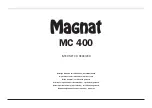
169
Web Server Help Files Collection
Configuration Tab
Before you select a message type from the drop-down list, you
can hold the mouse cursor over this message name in the
drop-down list. After about one second, a tip box will appear
providing the full definition of this message.
Note that for messages PTT, TTT and XDR, you don’t have to
define an output rate, due to the very nature of these
messages.
To change the settings of an existing message (port, rate),
select the corresponding row in the table. This populates the
three fields on the left with the settings of that message. Edit
the port and/or rate and then click on the
Modify
button. The
table row is updated accordingly. Remember you must always
click on the
Configure
button to save the changes in the
receiver.
Note that depending on the current selection on this page,
the button located underneath the three fields on the left may
be either grayed or with a different label (
Add
or
Modify
).
Deleting a message definition can be done by simply clicking
on the corresponding “trash” sign in the
Clear
column on the
far right. This deletes the table row.
There is also a
Clear All
button underneath the table that
allows you to delete all the message definitions from the table
in one click.
Raw Data
Two data formats are possible:
•
ATOM (navigation data and other data)
•
Ashtech Legacy (navigation data and other data)
Summary of Contents for HDS800
Page 1: ...Reference Manual HDS800...
Page 16: ...x Enabling a Firmware Option 639 Decoding an NTRIP Source Table 639 Logging Raw Data 642...
Page 54: ...38 Receiver Description...
Page 104: ...88 Using the Web Server...
Page 189: ...173 Web Server Help Files Collection Configuration Tab...
Page 266: ...250 Using Serial Commands...
Page 606: ...590 Query Command Library...
Page 619: ...603 Data Output...
Page 628: ...612 Data Output...
Page 650: ...634 Troubleshooting...
Page 660: ...644 Other Procedures Memos...
Page 676: ...X XDR 110 112 587 Z Z Blade 1 ZDA 347 431 588...
Page 677: ......
















































